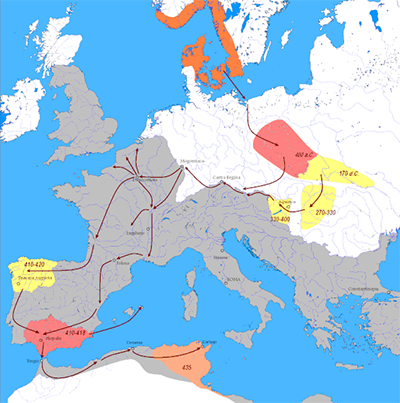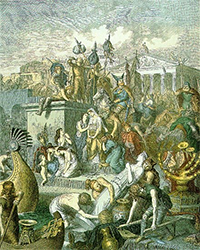The Vandals
The Vandals were one of the Germanic tribes that harried the Roman Empire in its waning days. In fact, the Vandals sacked Rome just a few decades before it fell. 
They are thought to have come from Scandinavia and then moved into what is now Poland in the 2nd Century B.C. At some point, the Vandals divided into two tribes, and one became allied with Rome. That alliance didn't last, and the Vandals soon joined their neighbors the Goths in periodically invading Roman territory. The emperor Aurelian led his army in defeating the Vandals in 271, pushing them back across the Danube. A few years later, another emperor, Probus, scored another pair of victories over the Vandals. As part of the peace agreement, many Vandals were allowed to join the Roman army but were shipped off to serve in Brittania. The rest moved to Pannonia. The emperor Constantine in 330 gifted land on the right bank of the Danube to a number of Vandals. They lived peacefully there for a few generations but then, as with other Germanic tribes, moved westward in order to escape the migrating Huns. In 406, the Vandals moved westward into Gaul, meeting resistance and finally defeating the Franks. Continuing onward, the Vandals crossed the Pyrenees in 409 and entered the Iberian peninsula, where Rome agreed to give them land. Not long afterward, the great Vandal king Gunderic rose to power. He defeated a force of Roman and Gothic armies at the Battle of Tarraco in 422 and then seized control of a handful of Roman settlements in Hispania (what is now Spain) and extended his way to the western Mediterranean Balearic Islands and even into North Africa. The death of Gunderic in 428 resulted in his half-brother Genseric's taking the throne and leading his people out of Hispania altogether. They migrated to North Africa in 429 and there set up headquarters. The Vandals took the rest of the North Africa and then eventually controlled Carthage and the just-off-Italy islands of Corsica, Sardinia, and Sicily. Rome at this time was beset by all manner of internal and external threats. Alaric and the Visigoths had sacked Rome in 410. Attila and the Huns had ravaged the countryside surrounding Rome in the 450s. Internally, a series of emperors had struggled to hold on to the throne. 
In 455, the emperor Valentinian III offered to marry his daughter to the son of the Vandal leader Genseric. The Vandals arrived in Rome and, finding that Valentinian had been killed by a usurper, sacked the city instead. They pillaged for two weeks. The Vandals didn't intend to hold Rome, so they soon departed. They continued to harass Roman possessions in Italy and in the Mediterranean, and Rome tried a few more times, unsuccessfully, to defeat the Vandals. The Romans gave up all hope of defeating the Vandals, agreeing to a peace in 476, the year that Rome finally fell. Genseric died the following year, and his successors proved not up to the task of fully defending the gains that their predecessors had stitched together during the previous decades. In-fighting between powerful generals weakened the Vandal hold on their kingdom, and into the breach left by the fall of the Western Roman Empire stepped the Byzantine Emperor Justinian I and his most famous general, Belisarius. Out of the in-fighting emerged one last powerful Vandal general, named Gelimer. He and Belisarius fought a series of battles against each other, but the Byzantines eventually got the better of the Vandals. Gelimer surrendered in 534, and the Kingdom of the Vandals was at an end. |
|
Social Studies for Kids
copyright 2002–2025
David White




